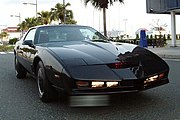There is no one definition of robot which satisfies everyone and many people have their own. For example Joseph Engelberger, a pioneer in industrial robotics, once remarked: "I can't define a robot, but I know one when I see one." According to the Encyclopaedia Britannica a robot is "any automatically operated machine that replaces human effort, though it may not resemble human beings in appearance or perform functions in a humanlike manner". Merriam-Webster describes a robot as a "machine that looks like a human being and performs various complex acts (as walking or talking) of a human being", or a "device that automatically performs complicated often repetitive tasks", or a "mechanism guided by automatic controls".
| KITT (a fictitious robot) is mentally anthropomorphic |
Defining characteristics
While there is no single correct definition of "robot," a typical robot will have several, or possibly all, of the following characteristics.It is an electric machine which has some ability to interact with physical objects and to be given electronic programming to do a specific task or to do a whole range of tasks or actions. It may also have some ability to perceive and absorb data on physical objects, or on its local physical environment, or to process data, or to respond to various stimuli. This is in contrast to a simple mechanical device such as a gear or a hydraulic press or any other item which has no processing ability and which does tasks through purely mechanical processes and motion.
- Mental agency
- A clockwork car is never considered a robot.
- A mechanical device able to perform some preset motions but with no ability to adapt (an automaton) is rarely considered a robot.
- A remotely-operated vehicle is sometimes considered a robot (or telerobot).
- A car with an onboard computer, like Bigtrak, which could drive in a programmable sequence, might be called a robot.
- A self-controlled car which could sense its environment and make driving decisions based on this information, such as the 1990s driverless cars of Ernst Dickmanns or the entries in the DARPA Grand Challenge, would quite likely be called a robot.
- A sentient car, like the fictional KITT, which can make decisions, navigate freely and converse fluently with a human, is usually considered a robot.
- Physical agency
- A player piano is rarely characterized as a robot.
- A CNC milling machine is very occasionally characterized as a robot.
- A factory automation arm is almost always characterized as an industrial robot.
- An autonomous wheeled or tracked device, such as a self-guided rover or self-guided vehicle, is almost always characterized as a mobile robot or service robot.
- A zoomorphic mechanical toy, like Roboraptor, is usually characterized as a robot.
- A mechanical humanoid, like ASIMO, is almost always characterized as a robot, usually as a service robot.



0 comments:
Post a Comment